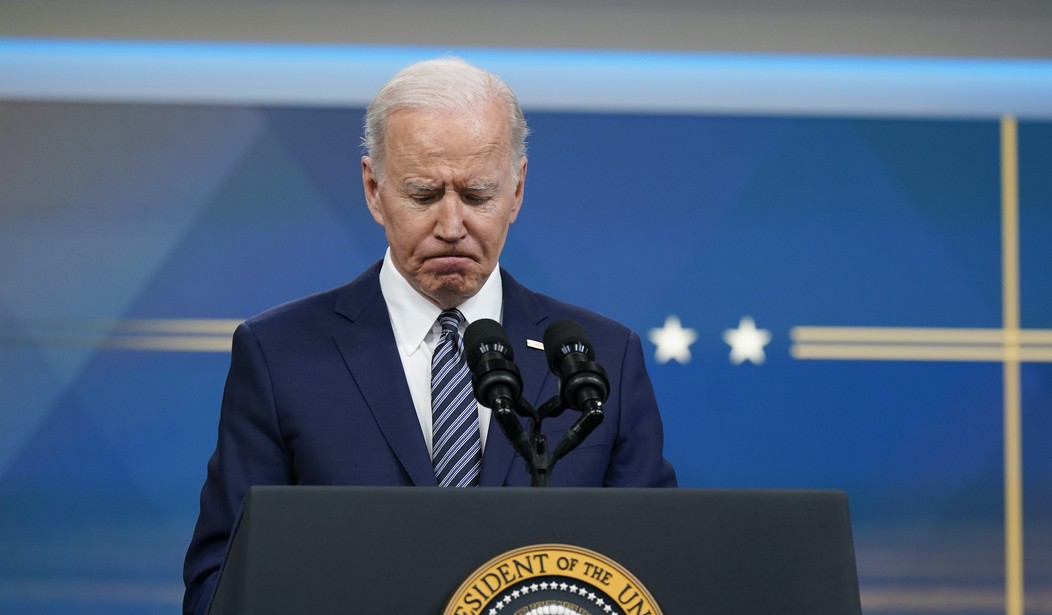If elections truly rest on the economy, Democrats’ vanishing hopes for the midterms just got a lot more difficult to detect. The Bureau of Economic Analysis reported this morning that the US economy shrunk in the first quarter, with an annualized GDP of -1.4%. It’s the first quarterly contraction since the pandemic-driven crater in 2020Q2, and a dramatic reversal from 2021Q4’s +6.9% annualized GDP growth.
But is it as bad as it looks?
Real gross domestic product (GDP) decreased at an annual rate of 1.4 percent in the first quarter of 2022 (table 1), according to the “advance” estimate released by the Bureau of Economic Analysis. In the fourth quarter, real GDP increased 6.9 percent.
The GDP estimate released today is based on source data that are incomplete or subject to further revision by the source agency (refer to “Source Data for the Advance Estimate” on page 3). The “second” estimate for the first quarter, based on more complete data, will be released on May 26, 2022.
The decrease in real GDP reflected decreases in private inventory investment, exports, federal government spending, and state and local government spending, while imports, which are a subtraction in the calculation of GDP, increased. Personal consumption expenditures (PCE), nonresidential fixed investment, and residential fixed investment increased (table 2).
What happened? This doesn’t have the hallmarks of coming stagnation, even in an inflationary environment like the current state of the US economy. Both consumer spending (+2.5%, only slightly off from 2021Q4’s +.2.7%) and business investment are up in Q1, although business investment is way off from the previous two quarters (+12.4% and +36.7%, respectively).
The big issues in this quarter appear to be a dramatic trade imbalance as well as a drop in government spending. The latter has been declining anyway; it went down 2.7% overall in Q1, but was also -2.6% in 2020Q4. Biden’s American Rescue Plan goosed federal spending by 11.3% in 2021Q2 (non-defense went up by 40.8%), and it has slowly descended ever since.
The trade imbalance, however, is dramatically bad in the first quarter. First off, recall that exports add to GDP and imports subtract from it. American exports fell by 9.6% in Q1, their worst showing since the 2020Q2 crater, while imports went up by 17.7%. Imports increased last quarter by a slightly higher percentage (17.9%), but exports were up 23.4% in 2021Q4 as well. That created a net add to GDP with a gap of 4.4 points. The net gap for this month is 27.4 points. It’s not tough to do the math as to why GDP ended up in negative territory while consumer spending and business investment increased.
So the good news is that the shrink is fairly technical. The bad news, however, is that there may be no reason to think that will only pop up in Q1. The supply chain issues in this country — both in goods and labor — are undoubtedly impacting our ability to export goods, while the importation of goods appears to be largely unaffected by it now. If that kind of massive trade imbalance continues into this quarter, we might end up with a technical recession, even though it won’t really be a classical recession or necessarily feel like it in terms of job growth and consumer spending.
This creates two very big problems for Democrats. The first is that voters really only pay attention to the topline numbers in these reports, a fact that benefited the White House when they got the 2021Q4 number. A negative GDP result will completely undo all of the administration’s happy talk about economic growth under Joe Biden and will put even more pressure on Democrats to separate themselves from Biden’s economic agenda ahead of the midterms.
The second problem is even worse. The Federal Reserve had been widely expected to get belatedly aggressive at taming inflation with a 50-basis-point increase in the interest rate. It’s entirely necessary as a tool to blunt the continued rise in inflation, even if it’s not actually sufficient. However, they have to walk a tightrope on preventing a recession while trying to get inflation under control. Any significant tightening now may make matters worse for the structural factors in this report by curtailing investment in economic-growth activities. That could make the Fed hesitant to follow through on interest-rate hikes in Q2 to avoid a technical recession — and that means inflation could run wild to the end of the year, all the way through the midterm cycle.
Small wonder, then, that media outlets rushed to assure everyone that today’s GDP report might somehow cloud their perception of the US economy. Americans’ perception of the economy has largely been accurate, which isn’t too surprising since they have to experience it every day. As long as inflation keeps raging, voters understand that their buying power is eroding, which will feel recessionary enough regardless of what the BEA reports. Until Biden and Democrats start addressing that issue effectively, they’re doomed in 2022 and likely in 2024.








Join the conversation as a VIP Member